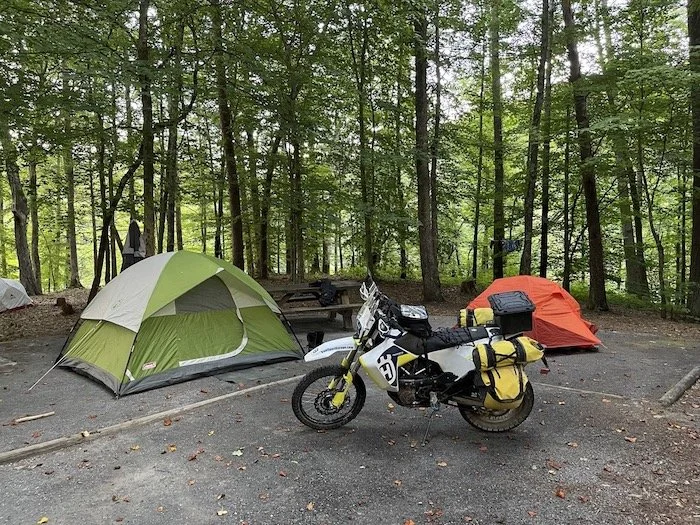Top Campsite Listings
Where to stay along the way…and how to find it.
Websites
There are many great camping websites that cater to hikers, campers and RV’s. It turns out, they also happen to be a great resource for adventure bikers planning overnight stays at campsites across the United States. Here are some of the best:
Recreation.gov: This website is the go-to source for booking campsites on federal lands, such as national parks, national forests, and Bureau of Land Management (BLM) areas.
ReserveAmerica.com: Similar to Recreation.gov, this website allows you to reserve campsites on state and federal lands.
Hipcamp.com: This website offers a variety of campsites, including public lands and private landowners who offer their land for camping.
Campendium.com: This website provides user-generated reviews of campsites across the country, making it a great resource for finding the best campsites based on other camper's experiences.
KOA.com: This website is the go-to source for finding private campgrounds across the United States.
GoCampingAmerica.com: This website provides a comprehensive directory of private campgrounds, RV parks, and resorts across the country.
Allstays.com: This website provides an extensive database of campsites, RV parks, and other camping-related facilities across the United States.
FreeCampsites.net: This website provides information on free camping options across the country, including public lands and other areas that allow dispersed camping.
While these sites should help you narrow your list to a few possible overnight locations. Step two will be to evaluate which sites on your short list suits you best.
Publications
I have found hiking, camping and outdoor publications are a great source of accurate feedback on many of the sites I have stayed at. This is valuable information as you work through your route planning hoping to stop at the best campsites along the way. They are also excellent for planning, preparation, and all things campsite related. Here are a few of those publications:
Backpacker Magazine: This publication features articles on hiking and camping gear, trails, and destinations, including information on campsites and camping options.
Outside Magazine: This publication covers a wide range of outdoor activities, including hiking and camping, and provides information on campsites and camping gear.
Camping.com Magazine: This publication is focused on camping and provides articles on camping destinations, tips and tricks, and reviews of camping gear, including tents and sleeping bags. The Camping Gem articles hare helpful for overnight destinations as well as scenic routes worth riding.
TrailGroove Magazine: This publication is focused on backpacking and provides articles on hiking trails, backpacking gear, and camping options, including campsites and backcountry camping.
National Parks Magazine: This publication is produced by the National Park Service and provides information on national parks, including camping options and campsites within those parks.
GearJunkie.com: This online publication covers outdoor gear and provides reviews of camping gear, including tents, sleeping bags, and camping stoves, as well as information on campsites and camping destinations.
The Dyrt Magazine: is a great resource for everything camping. From gear, food, campsite tips, to reviews and testimonials. Find the best camping tips with The Dyrt. The Dyrt is for campers, by campers.
Between publications like these, and the website above, you should have all the information you need to explore your campsite options, as well as prep for your trip.
Finally
When motorcycle camping, it is important to treat the campsites with care and minimize our impact on the environment. Here are few simple reminders:
Leave No Trace: Follow the Leave No Trace (LNT) principles, which includes traveling on and camping on durable surfaces, disposing of waste properly, leaving what you find, minimizing campfire impact, respecting wildlife, and being considerate of other visitors.
Durable surfaces: Camp on established sites or durable surfaces like gravel, dry grass, or snow to minimize the impact on vegetation and soil. Avoid riding off designated trails, as it can damage vegetation and contribute to erosion.
Waste disposal: Pack out all trash and waste, including food scraps. Use biodegradable soap and minimize water pollution by washing dishes and bathing at least 200 feet away from water sources.
Campfires: If campfires are allowed, use established fire rings or fire pans. Keep fires small and never leave them unattended. Put out fires completely before leaving the campsite.
Respect wildlife: Observe animals from a distance, and never feed them. Secure your food and trash properly to avoid attracting wildlife.
Always be a good neighbor: Respect other campers' space and privacy. Keep noise levels down, especially during quiet hours, and share communal facilities, like picnic tables or restrooms, with consideration. This can go a long way toward what the general public thinks of us adventure motorcycle riders.
Leave the site better than you found it: Before leaving your campsite, make sure to pick up any trash, put out your campfire completely, and restore the area to its natural state as much as possible.
Wherever you choose to stay, tread lightly, leave no trace, and have fun!
Ride on!



